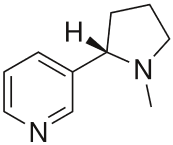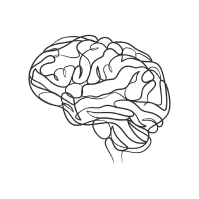NRT has been studied for decades.
Unlike vaping and other methods of quitting, nicotine replacement therapy has been thoroughly researched for over 50 years. The first NRT products were studied in Swedish submariners in the 1960s.¹ The FDA approved NRT for use in the US in 1984, and over-the-counter sales in 1996.² The combination of nicotine replacement therapy and behavioral support (like Jones) is clinically proven to be the most effective way to quit smoking.

NRT increases quit rates by 50-60%.
A review of 136 smoking cessation studies with 64,640 participants showed “high-quality” evidence that NRTs increase quit rates by 50-60%, regardless of setting.³ When using NRT, setting a quit date and quitting abruptly on that date is the most effective way to quit, and stay quit after 6+ months.⁴
Mobile digital behavioral support increases quit rates by nearly 40%.
A double-blind, randomized clinical trial with 2,588 young adult vapers showed that text-based motivation and behavioral support increased quit rates by nearly 40%.⁵ Plus, a review of 83 studies with nearly 30,000 participants showed that behavioral support like advice, counseling, and peer groups increased quit rates in those using NRT by an additional 20%.⁶
Separating nicotine from vaping & smoking.
The dangers of smoking, vaping, and other tobacco products are not derived from nicotine itself, which is why using NRT is a safe and effective way to quit. Research points to three key elements of tobacco products that cause harm:
Smoking, vaping, and chewing tobacco all contain toxic chemicals that have been linked to lung disease, heart disease, and various types of cancer. These chemicals are found in the smoke or vapor, not the nicotine.
The speed of nicotine delivery to your brain is key to understanding the addictive quality of various delivery mechanisms. Vapes & cigarettes deliver nicotine to the brain in ~10 seconds.⁷ Zyns & Snus produce higher maximum blood nicotine concentration in shorter time than NRT products of comparable strength.⁸
There are currently no regulations on vape strength in the US, meaning some vapes contain as much as 60mg of nicotine per mL of liquid (in the UK this is capped at 20mg). A 5% strength Elfbar BC5000 contains 650 mg of nicotine.⁹ On average, 1.5mg of nicotine are consumed per cigarette.⁸ Higher nic concentration means makes a delivery mechanism more addictive.
The Jones Method
Physiological

Nicotine Replacement Therapy (NRT)
Manage withdrawal symptoms and curb your cravings with steady, low doses of FDA-approved NRT.
Psychological

Behavioral Support via App, SMS, Community, & AI Coach Jones
Build new habits, coping strategies, and accountability.
Personal

Tailored to your needs. For Quitters, By Quitters.
Personalized support is proven to be more effective, and we know first hand that quitting is personal.
Frequently Asked Questions
Jones helps you quit by using a combination of nicotine replacement therapy (NRT), behavioral support (inspired by cognitive behavioral therapy, CBT), and community. We built our program in conjunction with our medical advisor, Dr. David Kan, at UCSF, who is an expert in addiction medicine.
Nicotine replacement therapy (NRT) is considered the first-line treatment in the medical community for most people who want to quit vaping, and it is available over the counter for adults or by prescription for children under age 18.
NRT is approved by the U.S. Food and Drug Administration (FDA) and is clinically shown to help people quit smoking - it can even double your chance of quitting successfully. Plus, more and more studies are coming out with clinical support for NRT’s benefits in quitting vaping. NRT is not yet approved by the FDA as a vaping cessation product, however, our medical advisor Dr. Kan and other addiction specialists highly recommend NRT to help with nicotine withdrawal when quitting vaping.
NRT provides nicotine gradually, so it helps reduce withdrawal symptoms and manage cravings without exposing you to toxic chemicals or giving the “head rush” that keeps you coming back to other nicotine delivery methods like smoking, vaping, or oral nicotine pouches.
It helps you quit by providing your brain with smaller doses of nicotine over time. This reduces withdrawal symptoms like irritability, grogginess, constipation, and cravings without spiking your blood nicotine (which is what continues your dependency).
You can think of NRT as a tool that provides you space to focus on building new habits and removing your behavioral dependency without simultaneously coping with severe withdrawal symptoms the way you would when quitting “cold turkey”. Once you’ve reset your habits and routine, you can gradually reduce your NRT intake. Most people feel they no longer need NRT and stop using it after a few months. Some choose to use NRT for longer, but this is still safer than continuing to use more harmful nicotine delivery methods.
YES, this is safe and effective - in fact, the risks and side effects of consuming NRT are very similar to those of caffeine. NRT does not contain the dangerous chemicals that are present in vapes or tobacco.
Doctors and other medical experts (including the CDC & smokefree.gov) recommend NRT as one of the most helpful tools you can use to quit. It’s been FDA-approved and heavily studied for over 30 years (the first NRT was used in 1967!), and the research shows that NRT is safe and effective for almost all adults looking to quit. NRT has been approved for over-the-counter use since 1996.
Most adults (anyone 18+) can take NRT without consulting a doctor. There are very few people who shouldn’t use NRT. Pregnant women, teens, and people with serious health issues (like heart or lung disease) still might be able to use NRT, but should talk to their doctor first. Some people are allergic to the compounds in NRT that don’t include nicotine but those people are very, very rare. If you have known sensitivities, we advise you to read the ingredients before taking NRT. People allergic to Soya products should not use nicotine lozenges.
It’s very rare to get serious side effects from using NRT. Mild side effects can occur, which usually don’t last long. For Jones nicotine lozenges, possible side effects include a tingling sensation, coughing, gas, heartburn, trouble sleeping, nausea, hiccups, racing heartbeat. Frequently, side effects are caused by incorrect use of NRT—for example, it’s important to allow the lozenges/mints dissolve in your mouth as opposed to chewing or swallowing them. This allows for gradual nicotine delivery which not only makes sure it works to relieve cravings and withdrawal symptoms, but also reduces the amount of nicotine you swallow, which can upset your stomach.
Generally, you can use NRT as long as needed. There are different programs available depending on your dependency and personalized needs but most recommend 10-12 weeks to taper NRT.
A 12-week treatment regimen includes:
- Use 1 lozenge every 1-2 hours for first 6 weeks.
- Use 1 lozenge every 2-4 hours for 3 additional weeks.
- Use 1 lozenge every 4-8 hours for 3 additional weeks.
This journey is 10-12 weeks for most people. For some people it might take longer. People for whom this will take longer might have more severe addictions. The presence of another mental health condition (depression and anxiety) also dictates a longer course of treatment.
The key is not to rush or pressure yourself, your pace is the right pace.
Absolutely. NRT was first designed to help smokers quit, and it's FDA-approved for this purpose. Your Jones NRT comes with specific guidance on using NRT to quit smoking.
If you are pregnant or breastfeeding, please consult with your healthcare provider to discuss your options for quitting.
We recognize that the world of vaping is clouded with misinformation, lack of resources, and mismatched recommendations. To us, impact means truth; we use our expertise for social good, keeping education and shared knowledge as primary touch points for the Jones experience.
We’re committing 1% of our profits to charitable organizations who are committed to countering the negative impacts of vaping and smoking on our health and planet.
What’s happening in my brain when I consume nicotine?
Nicotine
Receptor on your neurons (Nicotinic Acetylcholine)
- Nicotine binds to a receptor on the neurons in your “reward” and “fight or flight” pathways.
- This causes the release of three neurotransmitters, impacting your mood and mental state, while increasing your heart rate and blood pressure.
-
Dopamine — this makes you feel good
-
Acetylcholine — this helps you focus
Norepinephrine — this makes you feel alert
How does NRT actually work?
“Give me nicotine!”
“If I don’t get some nic, you’re gonna regret it!”
- Over time, your brain’s nicotine receptors become desensitized, so the brain adds more receptors.
- These new receptors are what cause cravings when you stop consuming nicotine because they’re expecting a “key” to unlock them. When that nicotine “key” doesn’t come, you feel withdrawal symptoms.
- The good news is, after a few weeks with no nicotine to fill the extra receptors, your brain can get rid of them and return back to normal.
- Because NRT delivers a slow, low dose of nicotine, it fills some but not all of your extra receptors. This allows your brain to start adjusting back to normal, without feeling such severe withdrawal symptoms.
Week 1
Week 4
Week 8
Week 12
Gradual reduction of nicotine receptors with the help of NRT means your cravings are more manageable while you quit.
- Harvard Health Blog; “Vaping: It's hard to quit, but help is available” by Sharon Levy, MD, MPH
- smokefree.gov; “Using Nicotine Replacement Therapy”
- smokefree.gov; “Busting NRT Myths”
- Centers for Disease Control and Prevention (CDC); “Three Reasons to Use Medicines When You Quit”
- Huberman Lab; “Nicotine’s Effects on the Brain & Body & How to Quit Smoking or Vaping”
- Truth Initiative Research and Resources
